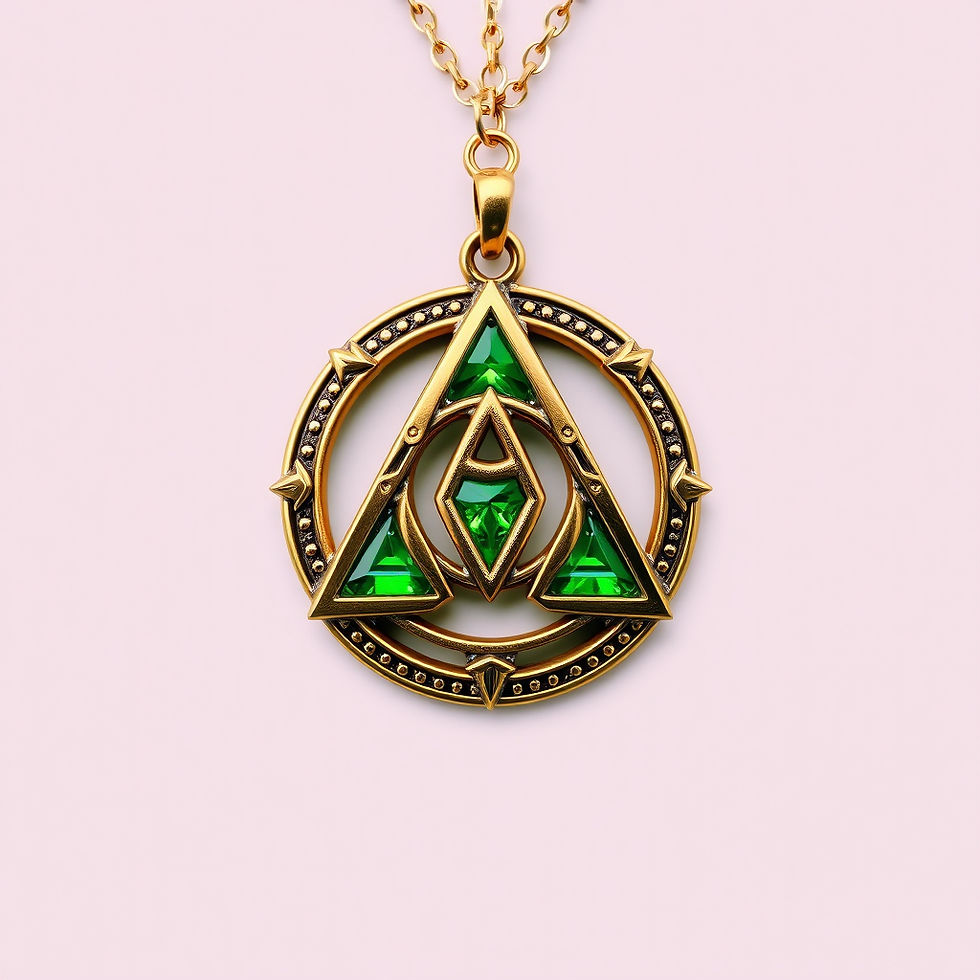The Triquetra: A Sacred Symbol of Unity, Power, and Magic
- Scarly

- Jul 25
- 4 min read
Among the countless sacred symbols woven into the tapestry of magical traditions, few carry the timeless resonance and spiritual potency of the triquetra. Also known as the trinity knot, this three-pointed symbol of interlocking arcs has captured the imagination of mystics, witches, and spiritual practitioners across cultures and centuries. Whether etched into ancient stonework, inscribed in a grimoire, or worn as an amulet, the triquetra radiates an energy of unity, cycles, and sacred balance, making it an incredibly versatile and meaningful tool in magical practice.

Origins and Meanings of the Triquetra
The word triquetra comes from Latin, meaning “three-cornered.” Although many associate it with Celtic spirituality, the symbol actually predates the Celts, appearing in Norse, Germanic, and early Christian iconography. Its earliest known uses date back over 5,000 years to Indo-European traditions, where it symbolized the triplicity of life.
In Celtic belief, the triquetra is often associated with the triple goddess, Maiden, Mother, and Crone, representing the cycle of life, death, and rebirth. It also speaks to the three realms: Earth, Sea, and Sky. In Norse mythology, the symbol was found on runestones and weaponry, believed to offer protection and connect the bearer to the divine. In Christian contexts, the triquetra was adopted to symbolize the Holy Trinity: Father, Son, and Holy Spirit.
Despite its varied origins, the essence of the triquetra lies in threes, a sacred number found across countless magical systems. It points to balance, harmony, and interconnection: past, present, and future; body, mind, and spirit; birth, life, and death.
The Symbol as a Magical Tool
Because of its rich spiritual associations, the triquetra can be used in numerous ways in magical practice. Whether you’re a solitary witch, part of a coven, or walking an eclectic path, this symbol can become a potent ally in your craft.
1. Protection Spells and Amulets
The triquetra’s interlocking loops create a continuous form that is often seen as a protective shield against negative forces. Worn as a pendant, drawn onto a candle, or engraved onto a charm bag, the triquetra acts like a magical barrier, especially when empowered with intention.
Use it this way: Draw the triquetra in chalk or salt at your front doorway to guard your home. Visualize the three arcs forming a glowing shield that filters harmful energies, only allowing in what serves your highest good.
2. Connecting with the Triple Goddess or Divine Feminine
For practitioners who honor the Goddess in her three aspects, Maiden, Mother, and Crone, the triquetra becomes a direct link to divine feminine wisdom. It can be used on an altar, in meditation, or as part of a moon ritual to attune to the different phases of the lunar cycle.
Use it this way: Place a triquetra symbol on your altar and decorate each arc with herbs or crystals corresponding to each goddess aspect. For example:
Maiden: rosemary, moonstone
Mother: rose, carnelian
Crone: mu gwort, obsidian
During a full or dark moon, use the triquetra as a focal point to call in the aspect of the goddess you wish to connect with.
3. Enhancing Spellwork with Symbolic Layering
Symbols carry subconscious power. Adding the triquetra to your spellwork adds a layer of sacred geometry, helping focus and amplify your magical intent, especially in workings involving cycles, transitions, and triadic relationships (such as love triangles, group dynamics, or decision-making).
Use it this way: Draw the triquetra in the center of your spell paper or carve it into a spell candle. Write your three related intentions in each of the loops. For example, for a transformation spell:
“Release Fear”
“Embrace Change”
“Welcome Growth”
As the candle burns or the spell is performed, visualize each arc activating and weaving your desires into the universe.
4. Meditation and Inner Balance
The triquetra represents the balance of forces, something essential in personal growth and inner alchemy. Gazing at the symbol during meditation can help harmonize conflicting energies within the self. It also serves as a meditative map of integration: mental, emotional, and spiritual alignment.
Use it this way: Sit comfortably and place a triquetra in front of you, this can be a physical symbol, a drawing, or even visualized in the mind’s eye. Breathe deeply, and as you trace the arcs with your mind, imagine yourself balancing the three aspects of your being:
The logical mind
The emotional heart
The intuitive soul
Do this regularly to stay grounded and centered, especially during times of personal upheaval.
5. Ritual Work in Threes
In rituals or spellcasting, incorporating the triquetra can help structure the process into three stages, invocation, manifestation, and release. This is especially useful in seasonal rites or initiation ceremonies, where cycles and transformation are at the heart of the work.
Use it this way: Design a ritual using the triquetra as the template. Each arc can represent a different part of the ceremony:
Arc One: Calling in allies, ancestors, or spirits
Arc Two: Performing the main working
Arc Three: Closing and giving thanks
Moving physically through each point of the triquetra drawn on the ground or altar space can make the ritual feel more immersive and intentional.

Final Thoughts
The triquetra is more than just a beautiful symbol, it is a portal to deeper understanding and sacred balance. It invites practitioners to honor the interconnectedness of all things, to find power in cycles, and to embrace the magic of threes. Whether used in protection, devotion, spellcasting, or meditation, the triquetra reminds us that everything in life is part of a rhythm, one that begins, transforms, and ultimately returns.
So the next time a spell calls for balance, a ritual calls for flow, or your spirit calls for connection, consider weaving the triquetra into your magical practice. In doing so, you'll not only invoke ancient wisdom, you’ll align with a sacred pattern that moves through all realms of existence.


Comments